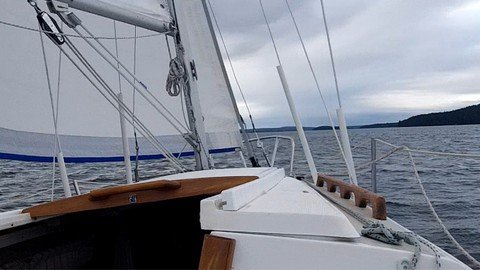
Last updated 11/2021
MP4 | Video: h264, 1280×720 | Audio: AAC, 44.1 KHz
Language: English | Size: 589.42 MB | Duration: 1h 38m
An explanation based on potential flow theory
What you’ll learn
Basic vector addition applied to lift, drag and driving forces on a sailboat.
An understanding of how a sailboat is able to make progress sailing into the wind.
Understand the usefulness of potential flow theory in the analysis of airfoils or sails.
The role of Bernoulli’s equation and circulation in explaining lift generation.
Understand the interaction between a mainsail and jib including concepts such as the "slot effect."
How a basic sailboat velocity prediction program (VPP) works.
Understand how, when sailing upwind, a boat’s sail affects the apparent wind of a boat to its stern.
Requirements
Basic STEM background likely needed to understand the more mathematical aspects in the course. However, much should be accessible to those without a STEM background willing to study the material. This would be particularly true of sailors who already have a good feel for sailing to windward and would like to learn some theory.
A computer that can run Microsoft Windows if you would like to download and run the available computer codes.
Description
This course focuses on aerodynamic lift with applications specifically geared toward sailboat sails. We discuss common simplified explanations for lift and point out deficiencies. We show how the equations of motion, under an irrotational flow approximation, can be reduced to a linear partial differential equation for a velocity potential from which we may compute the velocity. We then show how Bernoulli’s equation results from a simplification of the momentum equations and, given the velocity, allows one to compute the pressure. We also discuss the role of Kelvin’s theorem and circulation in providing a qualitive description of lift. A two-dimensional panel method program is also discussed and is available for download. The program is quite useful in looking at the interaction between a jib and mainsail. Toward the end of the course, we discuss the components of a simple velocity prediction program (VPP) and also discuss how, when sailing upwind, a sail may alter the wind field with respect to following boats. Several computer programs, available as executable files, and running only under Microsoft Windows, are available for download. (Please note I cannot guarantee the programs will run without issues on all computers. A student does not need to run the programs to benefit from the course.) The course is geared toward students with a STEM background, but may also be of interest to others who wish to skip some of the details.
Overview
Section 1: Introduction
Lecture 1 Course Outline and Sailboat Components
Lecture 2 Preliminary Material
Lecture 3 Airfoil Terminology
Lecture 4 Vector Force Diagrams for Sailing to Windward
Lecture 5 Interactive Force Vector Computer Program
Section 2: Aerodynamic Lift Generation
Lecture 6 Preliminary Discussion Regarding Lift
Lecture 7 Computing Lift
Lecture 8 Bernoulli Equation
Lecture 9 Explanation of Lift via Bernoulli Equation
Lecture 10 Explanation of Lift via Newton’s Laws
Lecture 11 Lift and Circulation
Lecture 12 Kelvin’s Theorem
Lecture 13 CFD Demonstration of the Kutta Condition
Lecture 14 Bathtub Experiment
Lecture 15 Superposition of Solutions to Potential Equation
Lecture 16 Thin Airfoil Theory and Panel Methods
Lecture 17 Panel Method Two-Dimensional Sail Analysis Code
Lecture 18 Summary Explanation on the Origin of Lift
Section 3: Additional Miscellaneous Topics
Lecture 19 Velocity Prediction Program
Lecture 20 Velocity Prediction Program Computer Code
Lecture 21 WInd Pattern Downwind of a Sail
Lecture 22 Wind Pattern Computer Code
Lecture 23 Navier-Stokes Solutions
Those interested in aerodynamics and/or sailing.
Homepage
https://www.udemy.com/course/aerodynamics-of-lift/
gxldh.Sailing.Aerodynamics.rar.html
Rapidgator
gxldh.Sailing.Aerodynamics.rar.html
Uploadgig
gxldh.Sailing.Aerodynamics.rar
NitroFlare
gxldh.Sailing.Aerodynamics.rar
